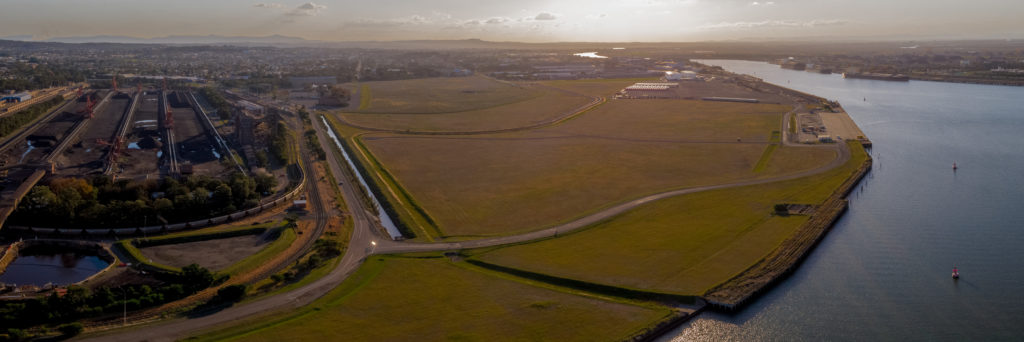Menu
Mayfield Concept Plan
The Mayfield development site is a 90-hectare parcel of port-side land. The site was once part of the former BHP Steelworks and has since been extensively remediated. It represents the largest vacant port land on the eastern seaboard of Australia.

About the Site
The site provides an important opportunity for Port of Newcastle to diversify the Hunter and NSW economies, and improve the efficiency of existing supply chains.
Port of Newcastle is seeking to develop the Mayfield site for port related activities in order to accommodate a diverse range of cargo handling infrastructure and grow new and existing trades. The site will, initially, be developed for bulk liquids. A multi-purpose cargo facility focused around bulk materials and general cargo has been identified as a future opportunity.
The Mayfield Site Port Related Activities Concept Plan (Mayfield Concept Plan) was approved by the NSW Department for Planning, Industry and Environment as a Concept Approval under section 75O of the Environmental Planning and Assessment Act 1979.
-
About the Mayfield Concept Plan
-
The Concept Plan establishes the broad parameters and environmental performance criteria to assess and develop future projects. It also provides a level of certainty for regulators and the local community that the site will be developed in a consistent and environmentally responsible manner.
The Concept Plan approval does not permit the construction or operation of any project. Future projects within the Concept Plan area are subject to separate approval(s) under the Act.
The proponent for the Mayfield Concept Plan was Newcastle Port Corporation until the commencement of the long-term lease of the Port of Newcastle. From 31 May 2014, Port of Newcastle is the proponent.
-
What is planned for the Mayfield site?
-
Port of Newcastle is seeking to develop the site for port-related activities to accommodate a diverse range of cargo handling infrastructure and the promotion of trade, in accordance with the objectives of the State Environmental Planning Policy (Three Ports) 2013.
The western portion of the site will initially be developed for bulk liquids. The timing of further development will depend on the commercial needs of port users.
-
Development Update
-
Stolthaven Mayfield Terminal
Stolthaven continues to meet its environmental reporting requirements as part of the Conditions of Approval issued in 2016 for the bulk fuel storage and distribution terminal. This terminal comprises seven diesel storage tanks and two biodiesel storage tanks, with approval to handle up to 3,500 million litres of fuel annually.Please refer to the latest Stolthaven reports under the SSD 7065 Reports section below.
Koppers Pipeline
Koppers Carbon Materials and Chemicals Pty Ltd (Koppers) has decommissioned and removed the gantry and pipe infrastructure that previously connected its Mayfield facility to the BHP 6 Berth.Koppers pipeline now connects to Mayfield 7 Berth, which is a dedicated bulk liquids berth.
Mayfield Cargo Storage Facility
The Mayfield Cargo Storage Facility will open its doors to diverse trades, including more wind turbine imports and roll-on roll-off vessels in the future, under the approved expanded site’footprint.Development Approval No. 8137 facilitates a Mayfield Cargo Storage Facility up to 18.6ha in size.
Port of Newcastle has been operating the Mayfield Cargo Storage Facility since July 2017. It comprises open-air storage for a range of cargo, including breakbulk, project, general and containerised cargoes.
Port of Newcastle Mayfield Services Project
Port of Newcastle continues to progress the Mayfield Services Project in preparation for the increased capacity needs of a potential new container terminal at Mayfield.Commissioning of a new electricial switching substation will be finalised in 2021 and is part of a $10 million investment to future-proof the capacity of the Mayfield site. Once commissioned, it will add 11.75 Mega Volt Amps (MVA) to the Port’s private electrical network. This project is being delivered in partnership with AvidPM, Downer EDI Engineering and GHD.Beyond the Mayfield Services Project
Port of Newcastle is currently progressing with a proposal to develop a Multi-purpose Deepwater Terminal at Mayfield.
Subject to the removal of the targeted tax on containers through Newcastle, Port of Newcastle is ready to invest $1.8 billion in the infrastructure needed to ensure Australia can accommodate the global shift towards the use of ultra large container vessels. With a groundswell of industry and political support for the project, the port will soon be in a position to provide a superior option for customers.
The Mutli-purpose Deepwater Terminal will help the Hunter’s economy to transition to a more diversified baseline and add further economic, social and environmental value.
-
Relevant Planning and Environmental Approvals, Licenses and Permits
-
Communication
-
You can keep up-to-date about this site and the development approval by:
- viewing the environmental monitoring information published on this web page
-
Compliance Overview
-
There are currently two facilities operating under the Mayfield Concept Approval:
- SSD_7065 Stolthaven Bulk Fuel Terminal; and
- DA 8137 Mayfield Cargo Storage Facility
As the proponent of the Mayfield Concept Plan Approval, Port of Newcastle publishes monitoring data on environmental performance.
-
Air Quality Monitoring and Management
-
Ambient air quality and wind data is currently monitored via the NSW EPA Lower Hunter Air Quality Monitoring Network.
The parameters monitored within the network are a basic set of fine particulates, combustion gases and wind speed and direction.
This set of parameters is able to provide a qualitative assessment of the impact on local air quality from the current activities within the Mayfield Concept Plan area until such time that future operations in the Mayfield Concept Plan area trigger the need for a higher level of monitoring.
-
Stormwater Quality Reporting
-
- 2019 September – November Stormwater Quality Report
- 2020 June – August Stormwater Quality Report
- 2020 September – November Stormwater Quality Report
- 2020 December – February Stormwater Quality Report
- 2021 March – May Stormwater Quality Report
- 2021 June – August Stormwater Quality Report
- 2021 September – November Stormwater Quality Report
- 2021 December – 2022 February Stormwater Quality Report
- 2022 March – May Stormwater Quality Report
- 2022 September – November Stormwater Quality Report
- 2022 December – 2023 February Stormwater Quality Report
- 2023 March – May Stormwater Quality Report
- 2023 June – August Stormwater Quality Report
-
Noise and Vibration Monitoring and Management
-
Operators are required to complete all statutory reporting requirements applicable to their operations within the time periods as specified within their consent and/or license conditions.
Port of Newcastle publishes an annual site-wide noise verification report.
-
Cumulative Impact Monitoring
-
Cumulative impacts of facilities operating under the Mayfield Concept Approval are assessed against total site criteria. Links to the cumulative assessment outcomes are provided above. Please refer to:
- Noise and Vibration Monitoring and Management (above)
- Traffic Monitoring and Review (above)
- Newcastle Air Quality Monitoring Network
-
Independent Environmental Audit
SSD 7065 Monitoring Reports
In accordance with the conditions stipulated in the development approval SSD 7065 the
Environmental Protection Licence 20193, Noise monitoring (NME) is an annual requirement occurring during the licenced reporting period.
-
2015
-
2016
-
- 2016 – January and February – Stolthaven Bi-Monthly Report
- 2016 – March and April – Stolthaven Bi-monthly report
- 2016 – July and August – Stolthaven Bi-Monthly Report
- 2016 – May and June – Stolthaven Bi-Monthly Report
- 2016 – September and October -Stolthaven Bi-monthly report
- 2016 – Stolthaven Bulk Fuel Storage Facility, Mayfield – Annual Review
-
2017
-
2018
-
- 2018 – January and February – Stoltaven Bi-Monthly report
- 2018 – July and August – Stolthaven Bi-Monthly report
- 2018 – March and April – Stolthaven Bi-Monthly report
- 2018 – May and June – Stolthaven Bi-Monthly report
- 2018 – November and December – Stolthaven Bi-Monthly report
- 2018 – November December – Stolthaven Bi-Monthly report
-
2019
-
- 2019 – January and February – Stolthaven Bi-Monthly report
- 2019 – March and April – Stolthaven Bi-Monthly report
- 2019 – May and June – Stolthaven Bi-Monthly report
- 2019 – March and April – Stolthaven Bi-monthly report
- 2019 – July and August – Stolthaven Bi-Monthly report
- 2019 – September and October – Stolthaven Bi-monthly report
- 2019 – November – December Stolthaven Bi-monthly report
- 2019 – Stolthaven Bulk Fuel Storage Facility, Mayfield – Annual Review
-
2020
-
- 2020 – January and February Stolthaven Bi-monthly report
- 2020 – March and April Stolthaven Bi-Monthly report
- 2020 – May and June Stolthaven Bi-Monthly report
- 2020 – July and August Stolthaven Bi-Monthly report
- 2020 – September and October Stolthaven Bi-Monthly report
- 2020 – November and December 2020 Stolthaven Bi-Monthly report
- 2020 – Stolthaven Bulk Fuel Storage Facility, Mayfield – Annual Review
-
2021
-
- 2021 – January and February Stolthaven Bi-Monthly report
- 2021 – March and April Stolthaven Bi-Monthly Report report
- 2021 – May and June 2021 Stolthaven Bi-Monthly Report
- 2021 – July and August Stolthaven Bi-Monthly Report
- 2021 – September and October Stolthaven Bi-Monthly Report
- 2021 – November and December Stolthaven Bi-Monthly Report
-
2022
-
- 2022 – January and February Stolthaven Bi-Monthly Report
- 2022 – March and April Stolthaven Bi-Monthly Report
- 2022 – May and June Stolthaven Bi-Monthly Report
- 2022 – July and August Stolthaven Bi-Monthly Report
- 2022 – September and October Stolthaven Bi-Monthly Report
- 2022 – November & December Stolthaven Bi-Monthly Report
-
2023
-
- 2023 – January & February Stolthaven Bi-Monthly Report
- 2023 – March & April Stolthaven Bi-Monthly Report
- 2023 – May & June Stolthaven Bi-Monthly Report
- 2023 – July & August Stolthaven Bi-Monthly Report
- 2023 – September & October Stolthaven Bi-Monthly Report
- 2023 – November & December Stolthaven Bi-Monthly Report
TRAFFIC MONITORING
Traffic Monitoring data is provided by individual tenants operating under the Concept Plan Approval to Port of Newcastle on a bi-monthly basis.
Port of Newcastle will regularly review Traffic Monitoring data. Port of Newcastle will prepare a Transport Infrastructure Strategy in consultation with agencies to help inform their planning of road and rail service provision and infrastructure upgrades.
-
2017
-
2018
-
2019
-
2020
-
2021
-
2022
-
2023
-
2024

Make an enquiry
Please use the form below to make an enquiry
